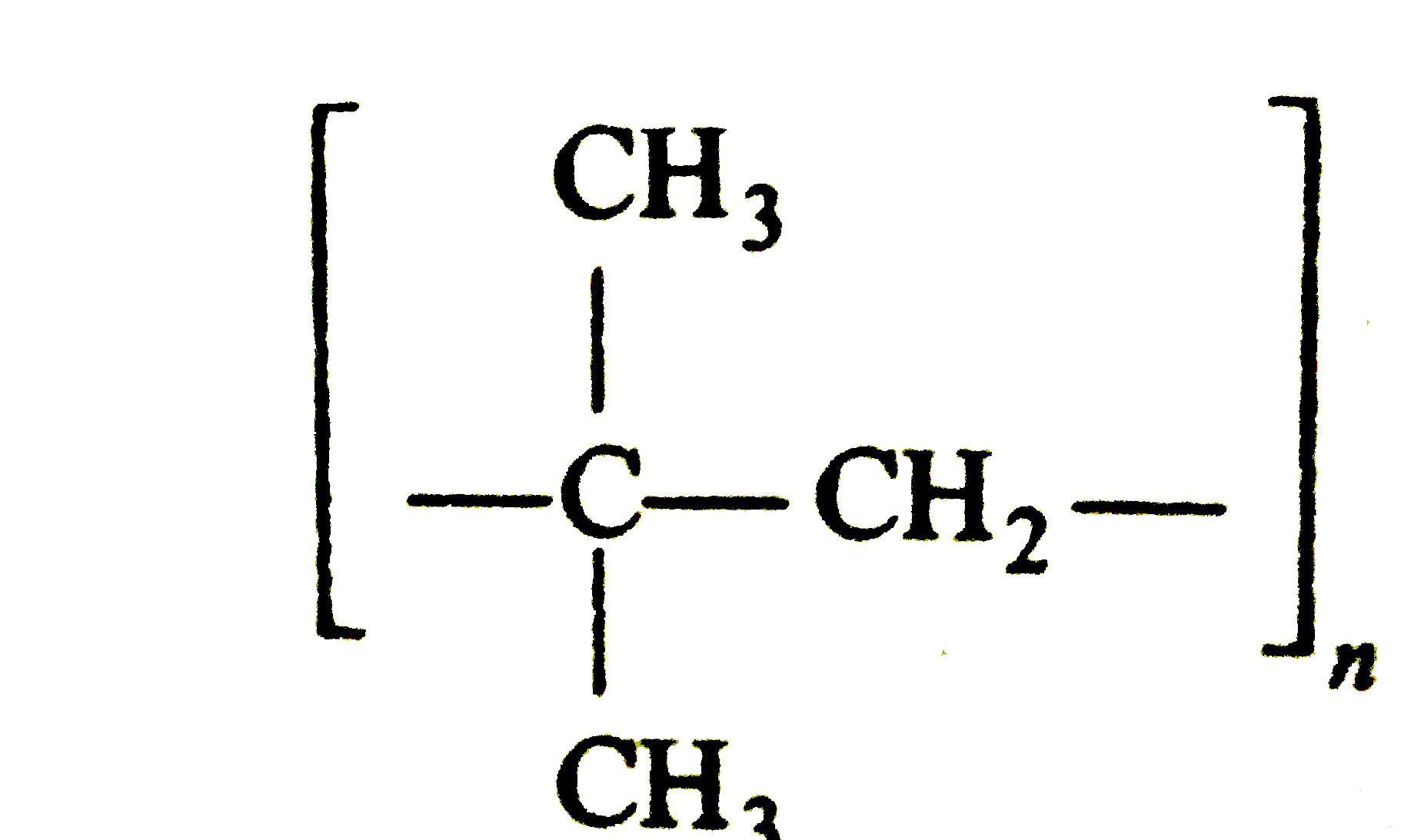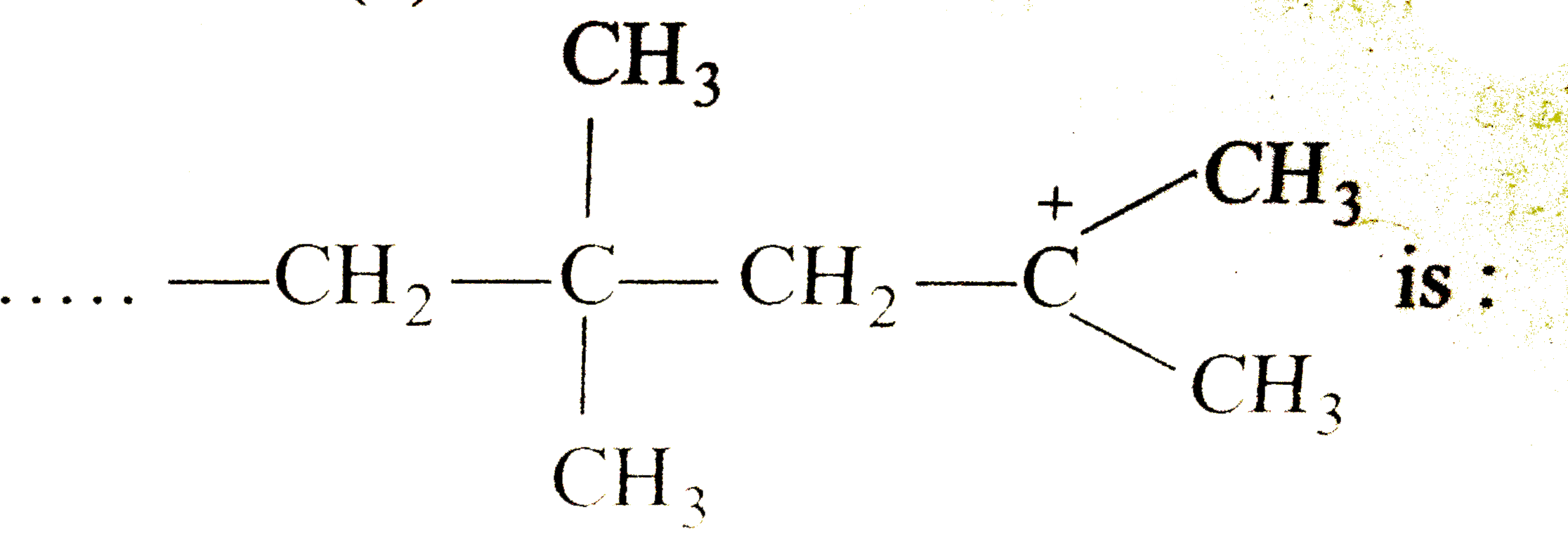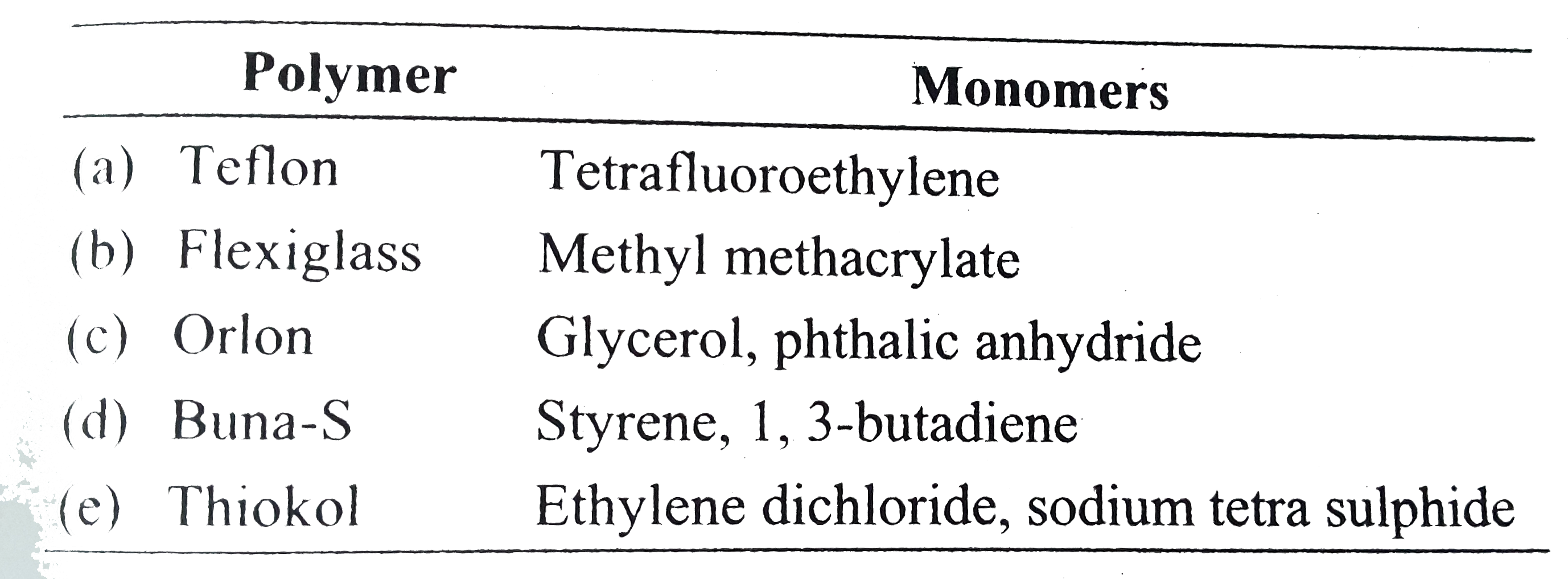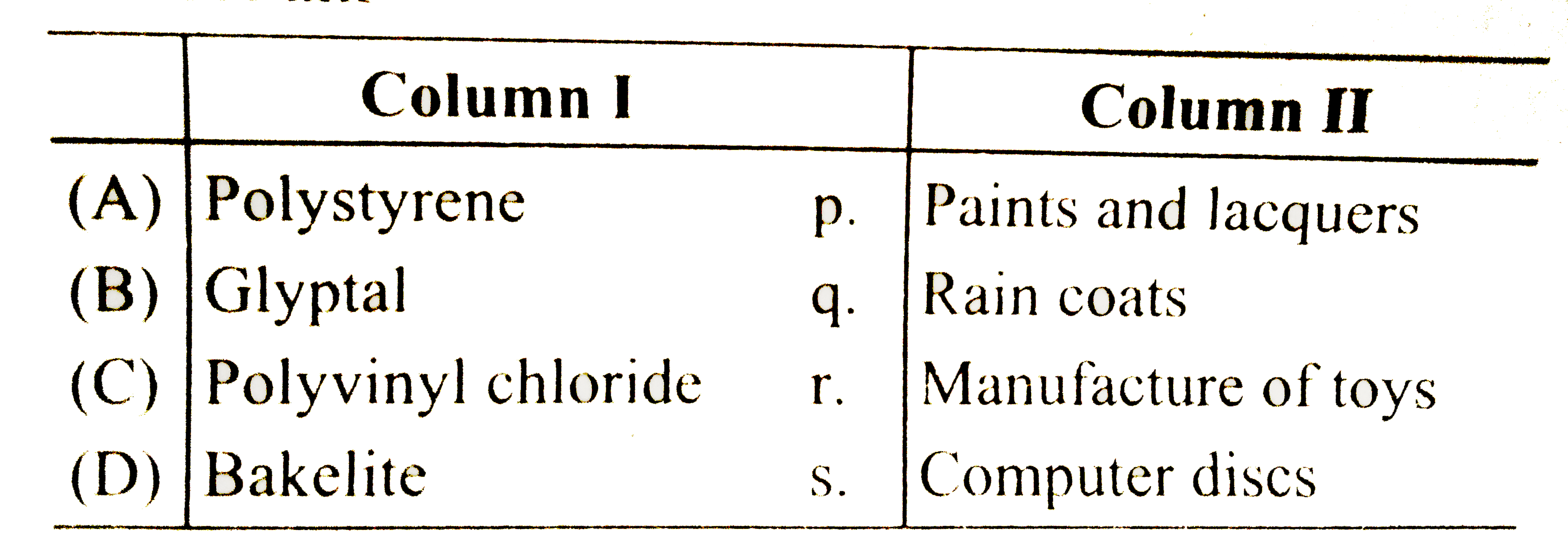Only One Correct Answer (Q.51 To Q.75) from GR BATHLA & SONS CHEMISTRY (HINGLISH) POLYMERS for Class 12
| Class 12 | CHEMISTRY |
| Chapter | POLYMERS |
| GR BATHLA & SONS CHEMISTRY (HINGLISH) | Only One Correct Answer (Q.51 To Q.75) |
| Medium | English |
| Academic Year | 2023-2024 |
Question 195
Monomers are simple molecules, which combine with each other to form polymers. Each polymer has a repeating structural unit. Polymers formed the same type of monomers are called homopolymers and if two or more different repeating units (monomers) make up the polymer, it is known as a copolymer. Both homopolymers and copolymers may be formed either by addition or condensation reactions. Alkenes and diense polymerize by addition (chain growth) mechanism involving carbocations, carbanions or free radical intermediates. Diense (Chloroprene, isoprene, etc) polymerize by 1,4-addition mechanism to give cis- or trans- polymers. Natural rubber is, however, cis- polyisoprene. Natural rubber is quite soft and flexible but these properties can be improved by a process called vulcanization. In contrast, bifunctional monomer molecules undergo condensation or step-growth polymerization. Polymers which can be heated and reshaped as many times as desired are called thermoplastics (polythene, polystyrene, PVC teflon, etc.) while those which can be heated only once to give a particular shape are called thermosetting polymers (Bakelite, Melmac, etc).
Vinyl chloride is the repeating unit in:View SolutionQuestion 196
Monomers are simple molecules, which combine with each other to form polymers. Each polymer has a repeating structural unit. Polymers formed the same type of monomers are called homopolymers and if two or more different repeating units (monomers) make up the polymer, it is known as a copolymer. Both homopolymers and copolymers may be formed either by addition or condensation reactions. Alkenes and diense polymerize by addition (chain growth) mechanism involving carbocations, carbanions or free radical intermediates. Diense (Chloroprene, isoprene, etc) polymerize by 1,4-addition mechanism to give cis- or trans- polymers. Natural rubber is, however, cis- polyisoprene. Natural rubber is quite soft and flexible but these properties can be improved by a process called vulcanization. In contrast, bifunctional monomer molecules undergo condensation or step-growth polymerization. Polymers which can be heated and reshaped as many times as desired are called thermoplastics (polythene, polystyrene, PVC teflon, etc.) while those which can be heated only once to give a particular shape are called thermosetting polymers (Bakelite, Melmac, etc).
Which of the following is not a natural polymer?View SolutionQuestion 197
Monomers are simple molecules, which combine with each other to form polymers. Each polymer has a repeating structural unit. Polymers formed the same type of monomers are called homopolymers and if two or more different repeating units (monomers) make up the polymer, it is known as a copolymer. Both homopolymers and copolymers may be formed either by addition or condensation reactions. Alkenes and diense polymerize by addition (chain growth) mechanism involving carbocations, carbanions or free radical intermediates. Diense (Chloroprene, isoprene, etc) polymerize by 1,4-addition mechanism to give cis- or trans- polymers. Natural rubber is, however, cis- polyisoprene. Natural rubber is quite soft and flexible but these properties can be improved by a process called vulcanization. In contrast, bifunctional monomer molecules undergo condensation or step-growth polymerization. Polymers which can be heated and reshaped as many times as desired are called thermoplastics (polythene, polystyrene, PVC teflon, etc.) while those which can be heated only once to give a particular shape are called thermosetting polymers (Bakelite, Melmac, etc).
Propene, styrene and ethylene glycol are:View SolutionQuestion 198
Monomers are simple molecules, which combine with each other to form polymers. Each polymer has a repeating structural unit. Polymers formed the same type of monomers are called homopolymers and if two or more different repeating units (monomers) make up the polymer, it is known as a copolymer. Both homopolymers and copolymers may be formed either by addition or condensation reactions. Alkenes and diense polymerize by addition (chain growth) mechanism involving carbocations, carbanions or free radical intermediates. Diense (Chloroprene, isoprene, etc) polymerize by 1,4-addition mechanism to give cis- or trans- polymers. Natural rubber is, however, cis- polyisoprene. Natural rubber is quite soft and flexible but these properties can be improved by a process called vulcanization. In contrast, bifunctional monomer molecules undergo condensation or step-growth polymerization. Polymers which can be heated and reshaped as many times as desired are called thermoplastics (polythene, polystyrene, PVC teflon, etc.) while those which can be heated only once to give a particular shape are called thermosetting polymers (Bakelite, Melmac, etc).
Which of the following, are example of thermoplastics?View SolutionQuestion 199
Monomers are simple molecules, which combine with each other to form polymers. Each polymer has a repeating structural unit. Polymers formed the same type of monomers are called homopolymers and if two or more different repeating units (monomers) make up the polymer, it is known as a copolymer. Both homopolymers and copolymers may be formed either by addition or condensation reactions. Alkenes and diense polymerize by addition (chain growth) mechanism involving carbocations, carbanions or free radical intermediates. Diense (Chloroprene, isoprene, etc) polymerize by 1,4-addition mechanism to give cis- or trans- polymers. Natural rubber is, however, cis- polyisoprene. Natural rubber is quite soft and flexible but these properties can be improved by a process called vulcanization. In contrast, bifunctional monomer molecules undergo condensation or step-growth polymerization. Polymers which can be heated and reshaped as many times as desired are called thermoplastics (polythene, polystyrene, PVC teflon, etc.) while those which can be heated only once to give a particular shape are called thermosetting polymers (Bakelite, Melmac, etc).
Which of the following are examples of homopolymers?View SolutionQuestion 200
A large numberof monomers (Simple molecules) combine together to form a larger molecule ( macro molecule) called as polymer. Each polymer is made up of a repeating structural unit. A polymer is said to be homopolymer if the structural unit is derived from one type of monomer molecules. if the repeating structural unit of a polymer is derived from more than one different types of monomers, the polymer is said to a copolymer. The homopolymers as well as copolymers may be formed by addition or condensation reactions. Alekenes and dienes polymerize by additions (Chain growth) mechanism involving carbocations, carbanions or free radical intermeidates. Dienes (Chloroprene) polymerise by 1, 4 addition mechanism to give cis or trans polymers. Natural rubber is, however, cis-polyisoprene. Natural rubber is quite soft and tacky but these properties can be improved by a process called vulcanization.
In contrast, bifunctional monomer molecules undergo condensation or step-growth polymerization. Polymers which can be heated and reshpaed as many times as desired are called thermoplastics (polyethene, polystyrene, PVC, teflon etc). While those which can be heated onoy once to give a particular shape are called thermosetting polymers (bakelite, melmac etc.)
Teflon, polystyrene and neoprene are all:View SolutionQuestion 201
A large numberof monomers (Simple molecules) combine together to form a larger molecule ( macro molecule) called as polymer. Each polymer is made up of a repeating structural unit. A polymer is said to be homopolymer if the structural unit is derived from one type of monomer molecules. if the repeating structural unit of a polymer is derived from more than one different types of monomers, the polymer is said to a copolymer. The homopolymers as well as copolymers may be formed by addition or condensation reactions. Alekenes and dienes polymerize by additions (Chain growth) mechanism involving carbocations, carbanions or free radical intermeidates. Dienes (Chloroprene) polymerise by 1, 4 addition mechanism to give cis or trans polymers. Natural rubber is, however, cis-polyisoprene. Natural rubber is quite soft and tacky but these properties can be improved by a process called vulcanization.
In contrast, bifunctional monomer molecules undergo condensation or step-growth polymerization. Polymers which can be heated and reshpaed as many times as desired are called thermoplastics (polyethene, polystyrene, PVC, teflon etc). While those which can be heated onoy once to give a particular shape are called thermosetting polymers (bakelite, melmac etc.)
Chloroprene is the repeating unit in:View SolutionQuestion 202
A large numberof monomers (Simple molecules) combine together to form a larger molecule ( macro molecule) called as polymer. Each polymer is made up of a repeating structural unit. A polymer is said to be homopolymer if the structural unit is derived from one type of monomer molecules. if the repeating structural unit of a polymer is derived from more than one different types of monomers, the polymer is said to a copolymer. The homopolymers as well as copolymers may be formed by addition or condensation reactions. Alekenes and dienes polymerize by additions (Chain growth) mechanism involving carbocations, carbanions or free radical intermeidates. Dienes (Chloroprene) polymerise by 1, 4 addition mechanism to give cis or trans polymers. Natural rubber is, however, cis-polyisoprene. Natural rubber is quite soft and tacky but these properties can be improved by a process called vulcanization.
In contrast, bifunctional monomer molecules undergo condensation or step-growth polymerization. Polymers which can be heated and reshpaed as many times as desired are called thermoplastics (polyethene, polystyrene, PVC, teflon etc). While those which can be heated onoy once to give a particular shape are called thermosetting polymers (bakelite, melmac etc.)
Which of the following sets contain only copolymers?View SolutionQuestion 203
A large numberof monomers (Simple molecules) combine together to form a larger molecule ( macro molecule) called as polymer. Each polymer is made up of a repeating structural unit. A polymer is said to be homopolymer if the structural unit is derived from one type of monomer molecules. if the repeating structural unit of a polymer is derived from more than one different types of monomers, the polymer is said to a copolymer. The homopolymers as well as copolymers may be formed by addition or condensation reactions. Alekenes and dienes polymerize by additions (Chain growth) mechanism involving carbocations, carbanions or free radical intermeidates. Dienes (Chloroprene) polymerise by 1, 4 addition mechanism to give cis or trans polymers. Natural rubber is, however, cis-polyisoprene. Natural rubber is quite soft and tacky but these properties can be improved by a process called vulcanization.
In contrast, bifunctional monomer molecules undergo condensation or step-growth polymerization. Polymers which can be heated and reshpaed as many times as desired are called thermoplastics (polyethene, polystyrene, PVC, teflon etc). While those which can be heated onoy once to give a particular shape are called thermosetting polymers (bakelite, melmac etc.)
Which is not a macro molecule?View SolutionQuestion 204
A large numberof monomers (Simple molecules) combine together to form a larger molecule ( macro molecule) called as polymer. Each polymer is made up of a repeating structural unit. A polymer is said to be homopolymer if the structural unit is derived from one type of monomer molecules. if the repeating structural unit of a polymer is derived from more than one different types of monomers, the polymer is said to a copolymer. The homopolymers as well as copolymers may be formed by addition or condensation reactions. Alekenes and dienes polymerize by additions (Chain growth) mechanism involving carbocations, carbanions or free radical intermeidates. Dienes (Chloroprene) polymerise by 1, 4 addition mechanism to give cis or trans polymers. Natural rubber is, however, cis-polyisoprene. Natural rubber is quite soft and tacky but these properties can be improved by a process called vulcanization.
In contrast, bifunctional monomer molecules undergo condensation or step-growth polymerization. Polymers which can be heated and reshpaed as many times as desired are called thermoplastics (polyethene, polystyrene, PVC, teflon etc). While those which can be heated onoy once to give a particular shape are called thermosetting polymers (bakelite, melmac etc.)
Which of the following sets contains only thermoplasters?View Solution
All Exercises from GR BATHLA & SONS CHEMISTRY (HINGLISH) Class 12 CHEMISTRY POLYMERS
- EXERCISE-1 (ONLY ONE CORRECT ANSWER)
- EXERCISE
- INTEGER ANSWER TYPE PROBLEMS
- INTER ANSWER TYPE PROBLEMS
- LINKED COMPREHENSION TYPE
- MATCH THE COLUMN
- MORE THAN ONE CORRECT
- ONLY ONE CORRECT ANSWER (Q.1 TO Q.25)
- ONLY ONE CORRECT ANSWER (Q.101 TO Q.125)
- ONLY ONE CORRECT ANSWER (Q.126 TO Q.150)
- ONLY ONE CORRECT ANSWER (Q.151 TO Q.175)
- ONLY ONE CORRECT ANSWER (Q.176 TO Q.189)
- ONLY ONE CORRECT ANSWER (Q.26 TO Q.50)
- ONLY ONE CORRECT ANSWER (Q.51 TO Q.75)
- ONLY ONE CORRECT ANSWER (Q.76 TO Q.100)
- EXERCISE-1 (ONLY ONE CORRECT ANSWER)
- EXERCISE
- INTEGER ANSWER TYPE PROBLEMS
- INTER ANSWER TYPE PROBLEMS
- LINKED COMPREHENSION TYPE
- MATCH THE COLUMN
- MORE THAN ONE CORRECT
- ONLY ONE CORRECT ANSWER (Q.1 TO Q.25)
- ONLY ONE CORRECT ANSWER (Q.101 TO Q.125)
- ONLY ONE CORRECT ANSWER (Q.126 TO Q.150)
- ONLY ONE CORRECT ANSWER (Q.151 TO Q.175)
- ONLY ONE CORRECT ANSWER (Q.176 TO Q.189)
- ONLY ONE CORRECT ANSWER (Q.26 TO Q.50)
- ONLY ONE CORRECT ANSWER (Q.51 TO Q.75)
- ONLY ONE CORRECT ANSWER (Q.76 TO Q.100)
- EXERCISE-2 (MORE THAN ONE CORRECT ANSWER)
- EXERCISE-2 (MORE THAN ONE CORRECT ANSWER)
- EXERCISE-3 (LINKED COMPREHENSION TYPE)
- EXERCISE-3 (LINKED COMPREHENSION TYPE)
- EXERCISE-4 (MATRIX MATCH TYPE)
- EXERCISE-4 (MATRIX MATCH TYPE)
- EXERCISE -5(INTEGER ANSWER TYPE PROBLEMS)
- EXERCISE -5(INTEGER ANSWER TYPE PROBLEMS)
 The product 'B" is:
The product 'B" is:

 is a:
is a:


 .
.



